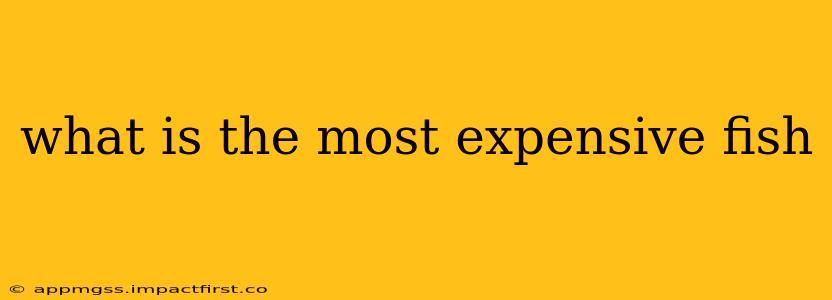What is the Most Expensive Fish?
Determining the single "most expensive fish" is tricky because pricing fluctuates based on size, rarity, seasonality, and location. However, several contenders consistently command exorbitant prices, often exceeding thousands of dollars per kilogram. This article explores some of the priciest fish in the world and the factors driving their high cost.
What makes some fish so expensive?
Several factors contribute to a fish's high price tag. These include:
- Rarity and Scarcity: Certain fish species are naturally rare due to their specific habitat requirements, slow growth rates, or limited breeding success. Lower supply naturally increases demand and price.
- Sustainable Farming Challenges: Some high-value fish are extremely difficult to farm sustainably. This limits supply and makes wild-caught specimens even more valuable.
- High Demand and Exclusivity: Certain species are highly prized in specific culinary cultures, driving up demand amongst affluent consumers. This exclusivity further inflates prices.
- Preparation and Presentation: The cost isn't always solely the fish itself. Elaborate preparation, presentation, and sourcing by high-end restaurants can significantly add to the final price.
What are some of the most expensive fish in the world?
While the exact ranking can shift, these fish consistently appear on lists of the world's most expensive:
-
Bluefin Tuna: Certain bluefin tuna, especially those caught in the Pacific, regularly fetch incredibly high prices at auction. The record price for a single bluefin tuna has reached hundreds of thousands of dollars. Their size, flavor, and the fact they're considered a delicacy contribute to their high cost. Overfishing is a major concern for this species.
-
Beluga Sturgeon: Prized for its caviar, the Beluga sturgeon is critically endangered, contributing to sky-high prices. The specific type of caviar (depending on age and size) and the strict regulations surrounding its harvest make it one of the most expensive seafood products.
-
Coelacanth: While not often consumed due to conservation concerns, the Coelacanth's rarity makes it exceptionally expensive (though not in a traditional market sense). This "living fossil" is incredibly rare, and its high price reflects its scientific significance rather than culinary value.
What other factors influence fish prices?
Beyond the inherent value of certain species, other factors play a role:
- Seasonality: Like other agricultural products, the availability of certain fish species varies throughout the year. Peak seasons often mean higher prices due to increased demand and reduced supply.
- Location and Transportation: Sourcing fish from remote locations or using specialized transportation methods adds to the overall cost.
Is it ethical to eat expensive fish?
The ethical considerations of consuming expensive fish often center around sustainability. Overfishing and unsustainable practices threaten many high-value species. Therefore, responsible sourcing and choosing sustainably farmed or responsibly wild-caught options are crucial. Checking for certifications from organizations committed to sustainable fishing practices can help consumers make informed choices.
Where can I buy expensive fish?
High-end fish are usually found at exclusive seafood markets, high-end restaurants specializing in sustainable seafood, and online retailers specializing in rare and exotic foods. It's important to verify the source and sustainability of the product before purchasing.
In conclusion, the "most expensive fish" isn't a fixed title. It's a constantly shifting ranking determined by multiple interacting factors, encompassing both the inherent value of the species and broader economic and environmental influences. Understanding these complexities allows for a more informed appreciation of the price and the importance of responsible consumption.
